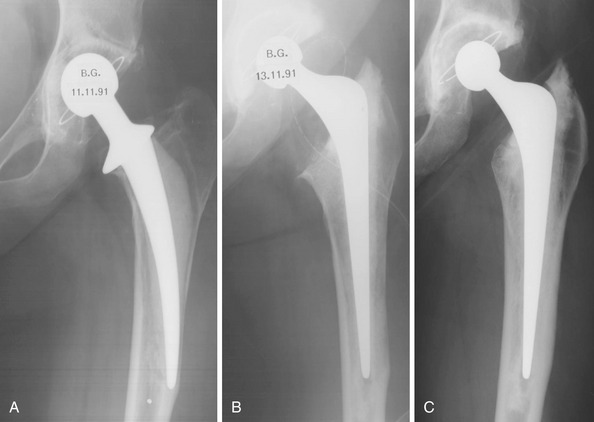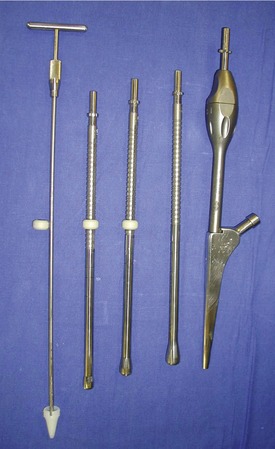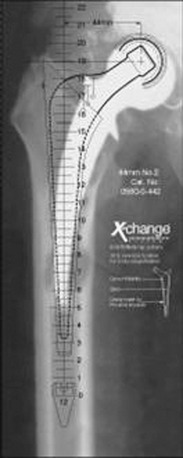CHAPTER 44 Surgical Options for Femoral Reconstruction Impaction Grafting
The technique was first performed in 1987 in Exeter, United Kingdom1 and has been used extensively since. The development of specialized instruments (Fig. 44-2) and refinement of the surgical technique have made the impaction process more reproducible and allow better compaction of the chips for stability and more consistent alignment of the prosthesis.2 The idea for the technique is an adaptation of impaction grafting of the acetabulum, a procedure that was pioneered in Nijmegen, Netherlands. In vitro work, along with retrieval specimens, shows that bone is often incorporated and remodeled, recreating a trabecular structure very similar to native bone, thus facilitating any revision procedure that subsequently needs to be performed.3
Femoral impaction grafting is a technically demanding procedure requiring attention to the details of the technique. Reinforcement of the femur on its periosteal surface using mesh or strut allograft is often required. Bypass of any deficient areas or stress risers with a long stem prosthesis has been found to be important, but when the rules for reconstruction have been adhered to, the technique has resulted in impressive clinical results at 15-year follow-up.4
INDICATIONS
Indications for the procedure include the following:
 Severe endosteal lysis of the femur, particularly in young patients, in whom it is important to replenish bone stock
Severe endosteal lysis of the femur, particularly in young patients, in whom it is important to replenish bone stock Where fixation would be compromised with the use of cement alone to fix the implant or where there would be inadequate fixation of an uncemented stem
Where fixation would be compromised with the use of cement alone to fix the implant or where there would be inadequate fixation of an uncemented stemPREOPERATIVE PLANNING
Templating
Femoral Component
From the radiographs the size, length, and offset of the stem required for revision are determined with the appropriate translucent revision templates (Fig. 44-3). The stem must bypass the most distal significant femoral defect—for example, a cortical defect or a significant lytic lesion (involving 50% or more of the cortex seen on two views)—by at least one, and preferably two, cortical diameters. The stems allow for 35.5 to 50 mm of offset and from 125 to 260 mm of length. The definitive stem offset and size are determined intraoperatively.
Indications for Use of a Long Stem
Long stems should be considered when there is cortical bone stock loss at a level corresponding to the stem tip of a conventional-length stem, when a periprosthetic fracture is present, and in cases of Endo-Klinik grade 3 or 4 bone stock loss.3 The stem tip should bypass any distal femoral lysis by a minimum of one cortical diameter (3 cm). Severe lysis or a fracture should be bypassed by at least two cortical diameters.




















